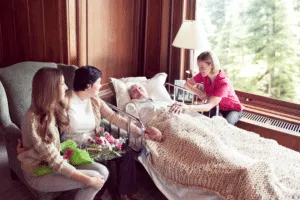According to the National Hospice and Palliative Care Organization (NHPCO), in 2020, 1.55 million patients received hospice care in the United States, and 84% were 65 years or older [01].As you can see with those remarkably high figures, hospice care is widespread across the United States as individuals age and face a life-limiting illness. Hospice and end-of-life care are meant for individuals with serious life-threatening illnesses requiring full-time care. However, there are some critical differences between the two.At Nurse Next Door, we offer hospice services at home or in the setting of your loved one's choice as they near the end of their life. We support clients daily with around-the-clock emotional and physical support as they navigate the next phase.This article breaks down the main differences between hospice, palliative, and end-of-life care. Read ahead to learn more!

What Is End-Of-Life Care?
End of life care refers to the medical care and support that is provided to someone who is nearing the end of their life. Essentially, end-of-life care is the umbrella term for all types of care when a person's life expectancy is limited due to illness. Hospice care and palliative care all fall under the broader spectrum of end-of-life care.End of life care can be provided in a hospice or palliative care setting but can also be provided in a hospital or at home. The goal of this type of care is to provide ultimate comfort and manage pain and other symptoms.
What Is Hospice Care?
Hospice care is a unique type of care that is designed to provide specialized support for individuals who are nearing the end of their lives. Although hospice care is typically provided during the final six months of their life, individuals can continue to receive this type of care for as long as they need it.Hospice care focuses on improving the person's quality of life and is centered around providing comfort rather than curing illness. Individuals typically receive this care in various settings, including a person's home, a hospice facility, or a hospital.
What Is Palliative Care?
The goal of both palliative and hospice are the same: to improve the person's quality of life. Palliative care also focuses on relieving symptoms and reducing stress associated with a severe illness, similar to hospice care. The one key difference between palliative care and hospice care is that palliative care can be provided at any stage of an illness. In contrast, hospice care is usually reserved for individuals nearing the end of their livesPalliative care can be prescribed during a consultation at a person's home, an outpatient office, select hospitals, and senior living communities. The care team usually includes a group of specialists, such as a palliative-trained, board-certified physician, nurse practitioner, social worker, and care coordinator. End-of-life care is provided by a team of healthcare professionals, including a board-certified physician, nurse practitioner, nurse, social worker, spiritual support counselor, certified home health aide, and volunteer.
What Are the 4 Levels of Care for Hospice?
There are 4 levels of hospice care depending on the person's needs including:
- Hospice At Home (Routine home care)
- Continuous Hospice Care
- Inpatient Hospice Care
- Inpatient Respite Care
1) Hospice At Home (Routine Home Care)
The most common level of hospice care is Hospice Home Care, provided to the patient in their home. A hospice team will visit your loved one regularly to provide medical care, symptom management, emotional support, and other services at home.
2) Continuous Home Care
Continuous Home Care is the next level of hospice care, which is provided when a person's symptoms require more intensive care. This level of care involves a hospice team that provides continuous support in the patient's home.
3) Inpatient Respite Care
Inpatient Respite Care is designed to provide temporary relief for caregivers caring for the patient at home. The patient is temporarily admitted to an inpatient hospice facility or hospital for up to five days to give the caregiver a break.
4) General Inpatient Care
The final level of hospice care is called "General Inpatient Care," which is provided when the patient's symptoms cannot be managed at home or in a nursing facility any longer. In this level of care, the patient is admitted to an inpatient hospice facility or hospital for intensive symptom management and medical care. The goal is to stabilize the patient's condition so that they can return to their home or another care setting.
What Is the Key Difference Between End-of-Life and Palliative Care?
It can be challenging to differentiate between palliative care and end-of-life care. Both focus on improving the quality of life for individuals living with serious illnesses. Palliative care is intended for anyone living with a severe illness at any stage, while end-of-life care and hospice care are for individuals with a prognosis of six months or less.Palliative care is focused on relieving the symptoms, pain, and stress associated with a serious illness and helps people live more comfortably with their condition. In contrast, end-of-life care and hospice aim to provide comfort care during the last few weeks, months, or days of a person's life.The main difference between palliative care and end-of-life care is the patient's medical treatment goals. Palliative care is for anyone seeking curative treatment, while end-of-life care is for someone who has decided not to receive curative treatments any longer and wishes to receive comfort care instead.At Nurse Next Door, we prioritize providing compassionate care and support to patients and their families during every stage of their illness, from palliative care to end-of-life care. We ensure patients receive the care they need to live as comfortably and peacefully as possible.

How to Decide Between Them?
Deciding between palliative or end-of-life care will typically be determined by a team of people, not just at the patient's discretion. Normally, doctors, healthcare team, caregivers, family members, a person's condition, life expectancy, and the level of care they need will all be influential factors in distinguishing between palliative care vs. hospice.Many people will also have different wishes when it comes to the final stages of their lives. Each person is unique in that they may want curative treatments until the very end or may choose comfort with pain and symptom management. Either way, there is no right or wrong way to receive care in the final stages.
If you or your loved one has any questions about the next phase, give us a call at
1-877-588-8609
One of our Care Consultants will happily guide you and support you and your loved one during this challenging time.

How to Find Hospice or End-Of-Life Care in Your Area?
Depending on your needs and desires, you or your loved one can receive end-of-life care at home or hospice services in a care facility.If your loved one's health drastically takes a turn, they may end up in the hospital due to their terminal illness. Typically, the doctors, social workers, and healthcare professionals at the hospital will make recommendations based on your loved one's condition and advise you on the next steps of where to receive treatment.A great resource is to contact your local or state office on Aging. Many organizations and their staff are qualified and available to help support families and individuals who are going through this difficult time.If your loved one wishes to remain at home or in a hospice facility during the final stages, Nurse Next Door can also help fulfill those wishes. Our main goals are to maintain your ultimate comfort, carefully explain the choices available to you and support your individuality to the best of our abilities.Nurse Next Door will put your needs first. We want to know where you would like to receive your care and where you want to spend your remaining days. We respect the psychosocial and spiritual needs of you and your family. We aim to reduce inappropriate and stressful decisions regarding your care setting, providing you with the option of home care whenever possible.Nurse Next Door's comprehensive healthcare team will look after your preparation for the end of life and support your relationships with your family members and healthcare providers while ensuring your loved one achieves a peaceful completion.Nurse Next Door is here to help you with end of life care and support you and your family during this extremely difficult time. We are here to help! Set up a FREE Caring Consult™ to receive support and plan for your hospice and palliative care.


























